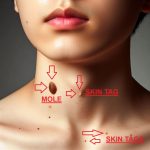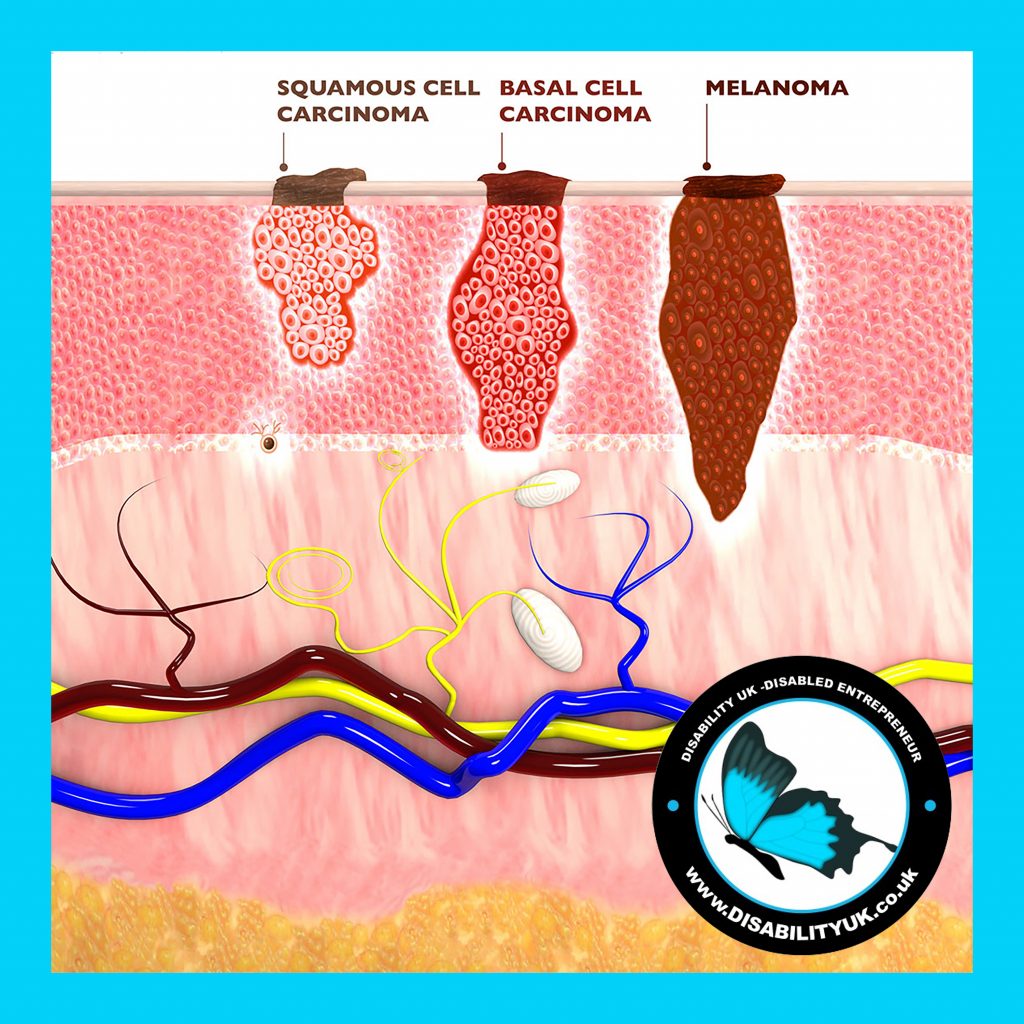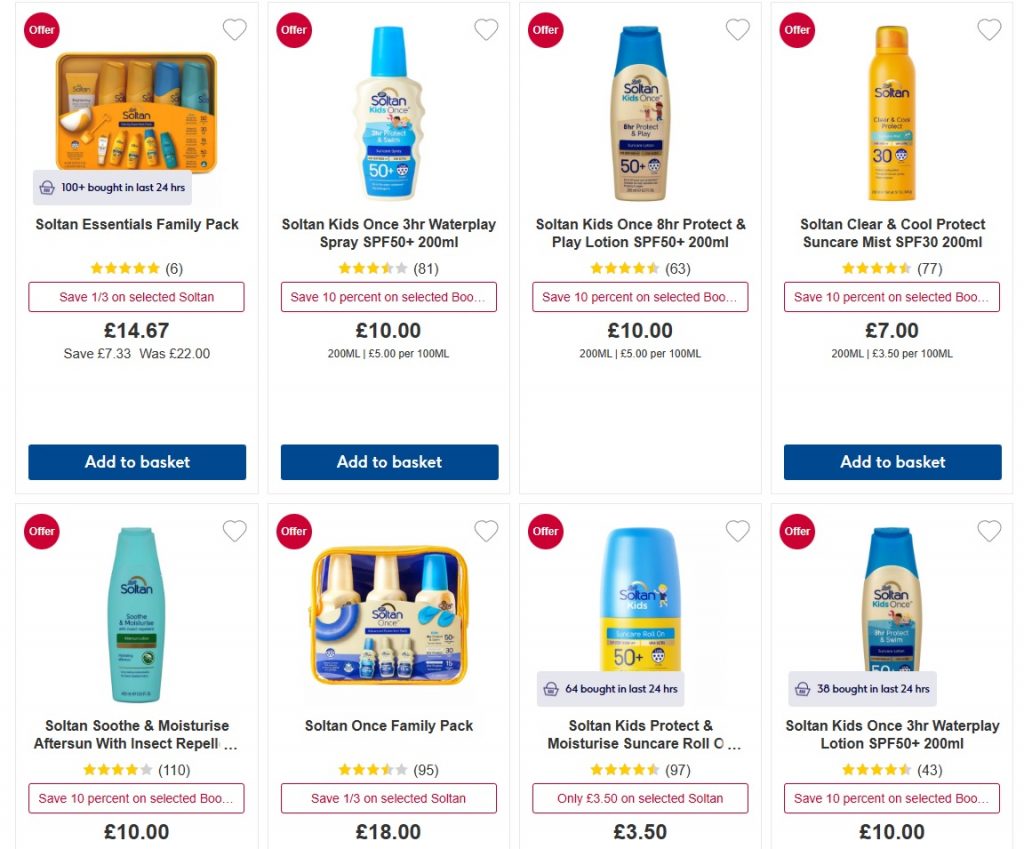
Recognizing Common Skin Growths: Skin Tags vs. Moles
Identifying the difference between a skin tag and a mole is crucial for proper skin health management. Skin tags and moles are common skin growths, but they have distinct characteristics that can help in their identification:
- Skin Tags:
- Appearance: Small, soft, flesh-colored growths that hang off the skin. They are usually painless and can be moved around easily.
- Location: Commonly found in areas where skin rubs against skin or clothing, such as the neck, armpits, groin, and under the breasts.
- Cause: Often result from friction, skin rubbing, and hormonal changes.
- Moles:
- Appearance: Can be flat or raised, and may vary in color from pink, brown, black, or blue. Moles are usually symmetrical with even borders.
- Location: Can appear anywhere on the body.
- Cause: Result from clusters of pigmented cells (melanocytes). Sun exposure and genetic factors can influence their development.
Characteristics of Concerning Skin Moles

Recognizing the characteristics of concerning skin moles is essential for early detection of potential skin cancers, such as melanoma. While many moles are benign, certain features can indicate a need for closer examination by a healthcare professional. The ABCDE rule is a helpful guide in identifying suspicious moles:
The ABCDE Characteristics Warning Signs. Do Not Ignore!

- Asymmetry: One half of the mole does not match the other half in shape, indicating irregularity.
- Border: The edges of the mole are ragged, notched, or blurred, rather than smooth and even.
- Color: The mole contains multiple colors or an uneven distribution of color, including shades of black, brown, tan, red, white, or blue.
- Diameter: The mole is larger than 6 millimeters (about the size of a pencil eraser), although some melanomas can be smaller.
- Evolving: The mole changes in size, shape, color, or elevation, or develops new symptoms such as bleeding, itching, or crusting.
Other warning signs include a mole that stands out as looking different from other moles on the body (known as the “ugly duckling” sign), or a mole that appears after the age of 30. If any of these characteristics are present, it is crucial to seek evaluation from a dermatologist, who can use tools like a dermatoscope to examine the mole more closely and determine whether further testing or removal is necessary. Early detection and treatment are vital for the best possible outcomes in managing skin cancer.
Skin Mole Risk Factors to Keep in Mind
- Genetics:
- Family history of skin cancer or atypical moles.
- Skin Type:
- Fair skin, light hair, and light eyes.
- Skin that burns or freckles easily.
- Sun Exposure:
- History of frequent sunburns, especially in childhood.
- High cumulative exposure to UV radiation from the sun or tanning beds.
- Number of Moles:
- Having a large number of moles (more than 50).
- Presence of atypical or dysplastic moles.
- Age:
- Older age increases the risk of skin cancer.
- Immune System:
- Weakened immune system due to conditions such as HIV/AIDS or immunosuppressive medications.
- Skin Injuries:
- Chronic irritation or trauma to a mole.
- Hormonal Changes:
- Hormonal changes during puberty or pregnancy can affect moles.
- Personal History:
- Previous history of skin cancer increases the risk of new melanomas.
- Geographic Location:
- Living in areas with high UV radiation levels (closer to the equator or at high altitudes).
- Chemical Exposure:
- Exposure to certain chemicals that may increase the risk of skin cancer.
- Gender:
- Men have a higher risk of developing melanoma on the trunk, head, or neck, while women are more likely to develop it on the legs.
The Role of Dermatoscopes in Diagnosis
A definitive diagnosis cannot be made through a photograph or a phone consultation. A dermatoscope is an essential tool used by dermatologists to examine skin lesions closely. This instrument allows healthcare providers to observe the intricate details of the skin, such as color patterns and microstructures, which are not visible to the naked eye.
What is a Dematoscope
A dermatoscope is a specialized medical instrument used by dermatologists to examine skin lesions with greater clarity and detail than what is possible with the naked eye. It consists of a magnifying lens, a light source, and often a digital interface to capture and analyze images. The dermatoscope illuminates and magnifies the skin, allowing the observer to see structures and patterns beneath the surface, which are crucial for distinguishing between benign and malignant lesions. This tool is essential for accurate diagnosis and treatment planning, providing a more comprehensive assessment of moles, skin tags, and other skin abnormalities.
Concerns for Patients Treated with Alemtuzumab
Alemtuzumab, a medication used primarily in the treatment of multiple sclerosis and certain types of leukemia, has been associated with an increased risk of malignancies. Patients treated with alemtuzumab need to be monitored closely for any new or changing skin lesions, as they may be at a higher risk for developing skin cancer.
Importance of Qualified Healthcare Professionals
In the UK, there has been ongoing controversy regarding the qualification and training of nurses in diagnosing skin conditions. While nurses play a crucial role in the healthcare system, it is imperative that patients with potential skin malignancies are evaluated by a properly trained and qualified healthcare professional, such as a dermatologist. Failing to do so can lead to misdiagnosis and delayed treatment, increasing the risk of adverse outcomes.
Medical Negligence and Patient Advocacy
Medical negligence occurs when a healthcare provider fails to deliver the standard of care that a reasonably competent provider would have delivered under similar circumstances. If a patient feels that their concerns have been undermined or not taken seriously, particularly in cases where there is a risk of cancer, this can be a significant issue. Practices that do not thoroughly investigate and address patient concerns should be scrutinized and, if necessary, investigated for their practices.
Addressing Concerns and Seeking Proper Care
Patients should feel empowered to seek second opinions if they feel their concerns are not being adequately addressed. It is essential to advocate for one’s health, especially when dealing with potential malignancies. Trust in the healthcare system is built on thorough, compassionate, and competent care. Any deviations from this standard should be taken seriously and reported to relevant regulatory bodies to ensure patient safety and trust in the healthcare system.
Editorial Note: Concerns Over Patient Care at Cardiff GP Surgery
It has recently come to the editor’s attention that a general practitioner surgery in Cardiff UK dismissed a patient’s concerns with an undermining and condescending tone. The patient, who requires regular monitoring for skin abnormalities, reported that a nurse over the phone appeared oblivious to the seriousness of her condition. The patient had legitimate concerns, but the nurse made a diagnosis over the phone and only looked at an image, without referring the patient to a specialist. The nurse asserted that only she could decide whether to investigate further, giving the patient the choice of either coming in immediately or waiting until the nurse returned from holiday.
The editor strongly believes that a General Practitioner (GP) is more qualified to make such decisions and that it should not be left to a nurse to determine the need for specialist referral. This is not the first time this particular surgery has come onto the editor’s radar. The editor has begun to compile evidence on these incidents. It is particularly concerning that, amidst a broader scandal involving nurses, this particular nurse exhibited a complacent attitude.
In the patient’s defense, she could not come into the surgery for a physical examination today, as she had already made plans that could not be broken on such short notice.
The healthcare sector has a fundamental duty of care to work collaboratively with patients, ensuring their well-being and addressing their concerns with professionalism and empathy. This involves listening attentively to patient needs, providing accurate and timely diagnoses, and referring to specialists when necessary. Healthcare providers must strive to make the patient experience as stress-free as possible, avoiding unnecessary difficulties or dismissive attitudes that can exacerbate a patient’s anxiety and potentially compromise their health outcomes. A compassionate and patient-centered approach is essential for maintaining trust and delivering high-quality care.
Such practices raise significant issues regarding patient safety and professional competence and warrant thorough investigation.
Conclusion
Distinguishing between skin tags and moles is vital for managing skin health, especially for individuals with a higher risk of cancer due to treatments like alemtuzumab. Proper diagnosis requires the use of dermatoscopes and evaluation by qualified healthcare professionals. Patients must be heard and their concerns addressed with the seriousness they deserve. Medical practices that fail to do so should be investigated to uphold the standards of patient care and trust.
Healthcare workers who exhibit condescension and a lack of empathy towards patients must undergo retraining to improve their communication and patient care skills. When healthcare professionals dismiss or undermine a patient’s concerns, especially regarding potential skin cancers, the consequences can be dire. If a patient’s mole, initially dismissed, later turns out to be cancerous, the healthcare provider could face serious legal repercussions, including lawsuits for medical negligence. Ensuring that healthcare workers listen attentively, validate patient concerns, and take appropriate actions is not only essential for patient safety and trust but also for protecting medical practices from legal liabilities. This underscores the importance of continuous professional development and empathy training in healthcare settings.
Further Reading:
- Mole Vs. Skin Tag: Understanding the Difference (healthline.com)
- Skin Moles to Worry About: 5 Suspicious Signs (verywellhealth.com)
- https://disabledentrepreneur.uk/the-nhs-nursing-scandal-a-crisis-in-training-and-oversight/
- Dermatoscope: What is it used for and what does it see? (medicalnewstoday.com)
- Relapsing MS Infusion Treatment: LEMTRADA® (alemtuzumab)
- NHS Wales complaints and concerns: Putting Things Right | GOV.WALES



















